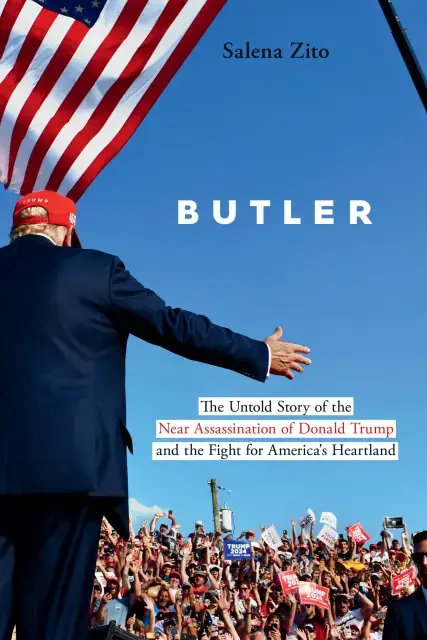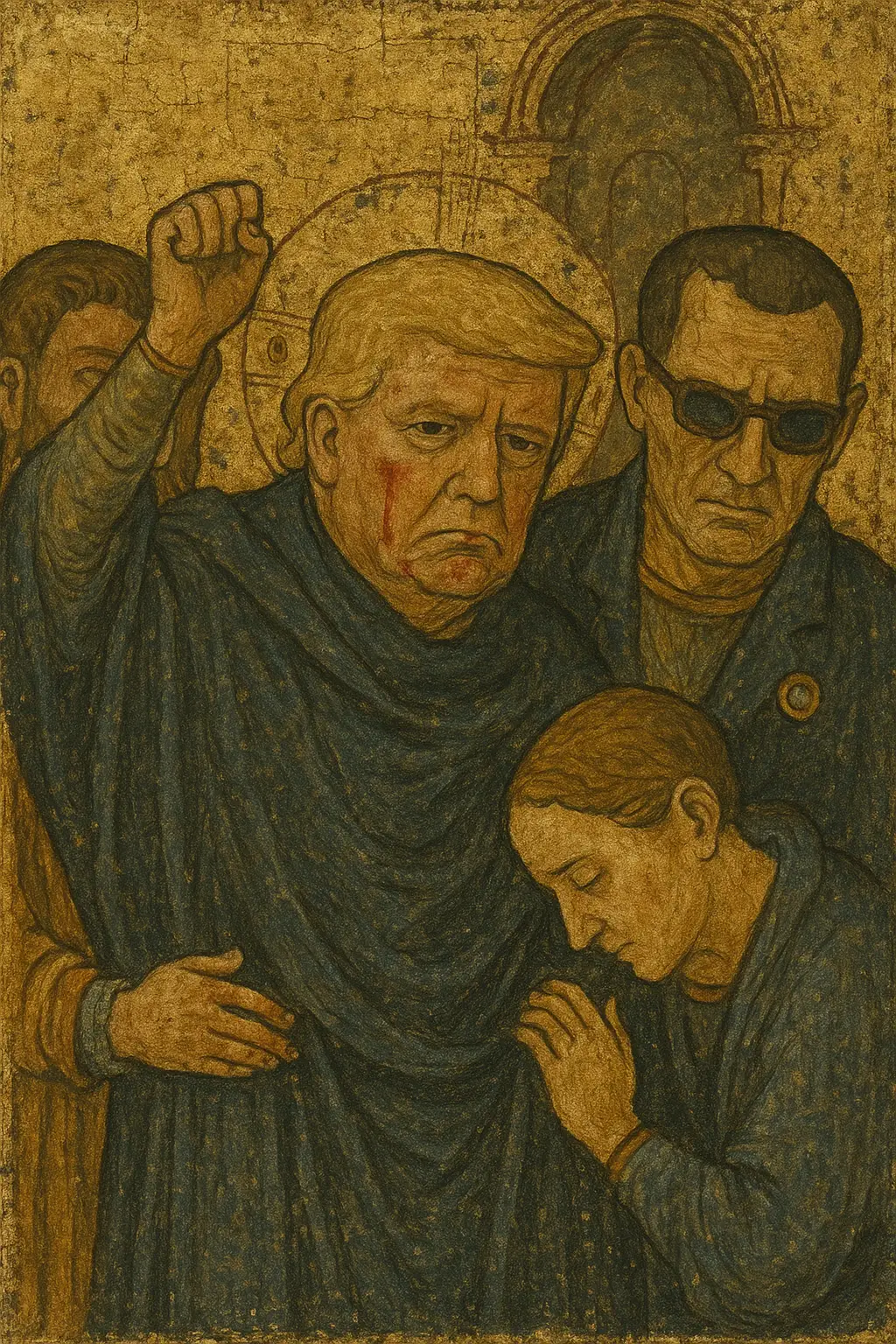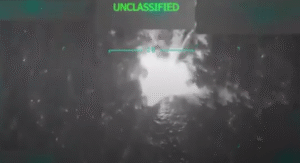It used to be about where you were when JFK was shot, or when the twin towers fell. Your age determined the touchstone. Today it’s where you were when Donald Trump got his ear nicked by a bullet. Or maybe by a flying bit of Teleprompter. (Ironic, given how often he goes off script.) Or am I remembering it wrong? It doesn’t matter. The facts have already been flattened into image: blood on the podium, fist in the air, “Fight! Fight! Fight!” echoing through the crowd in Butler, Pennsylvania.
I don’t remember if the blood came before the chant or after. Maybe it doesn’t matter. Maybe that’s the point. It’s already slipped from sequence into symbol. Living in Britain, we woke up to it. Or did we? The clip was already everywhere. The blood on his face, Secret Service dragging him off stage, the fist. For a few seconds, before the headlines clarified he was fine, we were left in the in-between. And if we’re honest, some of us were kind of hoping it had worked. Not because we wanted him dead, exactly. But because we couldn’t bear another year of this. The theatre, the violence, the immunity. It felt like watching history try and fail to correct itself in real time.
A few days later, at the Republican National Convention, Trump stood beside a firefighter’s jacket and helmet. Those of Corey Comperatore, the local fire chief killed shielding his family during the shooting. The gear was displayed on a coat stand, name patch and all, though even the name was slightly off: “Compertore,” a long-standing misspelling. Trump walked over, placed his hand on the helmet, and kissed it. It wasn’t just a tribute, this was liturgy. A moment of national grief repurposed for political theatre. A civilian’s sacrifice framed as a martyr’s gift. The president-as-survivor blessing the relics of the dead.
Trump stood beside the helmet and coat. Touched it. Kissed it. I still don’t know what I was supposed to feel watching that.

That’s where Salena Zito begins Butler. But this isn’t reporting. It’s canon-building. Zito’s not covering a campaign, she’s turning it into scripture. Trump doesn’t just survive the assassination attempt. He’s transfigured by it. Butler reads like a gospel written by a believer too shy to say amen out loud.
“I saw him flinch. He grabbed his right ear. I saw the blood drip from his face and down his arm,” Zito writes. It’s not description, it’s stigmata.
From crowd to congregation
Zito still knows how to sketch a scene. She describes the heat, the folding chairs, the hats, the country fiddlers. The book captures the strange calm of the moments before the shot. But the way she writes the crowd now isn’t just observational—it’s reverent.
“Time seemed to stop. Everything that was happening, was happening in split-second layers.”
“Everyone was just still, frozen, and quiet. The energy of the crowd had completely changed.”
These aren’t rally goers any more. They’re a congregation waiting for revelation. There’s no political content here. No arguments. Just presence. Loyalty. The shared belief that Trump belongs to them, and to history.
“He is chosen,” one supporter says, and Zito offers no pushback. She just lets it sit there, glowing.
This is the real message of Butler: Trump didn’t die. So he must win. There’s no real tension. No introspection. Just a movement baptised by blood and confirmed by survival.
Mood over meaning
Zito’s last book, The Great Revolt, did something useful. It mapped the voters who delivered 2016 to Trump. It made space for contradiction. There were no halos. People were messy. They voted for jobs, or against Clinton, or because they liked the noise.
That ambiguity is gone now. The voters in Butler aren’t hedging anything. They’re believers. Trump has become less a candidate and more a vessel for longing, for defiance, for wounded pride. Zito doesn’t analyse that shift. She rides it.
“You could feel the hand of God on him,” someone tells her. This now becomes the book’s mood music.
Zito doesn’t ask what it means to build a campaign on blood and spectacle. She never even flinches at the theology. Instead, she folds it into the atmosphere. This is flag-waving, God-fearing, tears-on-the-cheek Americana. Butler isn’t about Trumpism’s direction. It’s about its feeling.
The bullet as blessing
The bullet should have been the rupture. A break in the story. A moment of reckoning. But in Zito’s hands, it becomes a narrative hinge. A gift. The bullet doesn’t shock. It sanctifies. It proves Trump’s righteousness.
“If muskets had contained rifling… Washington might have been killed. Then what?” Zito asks, folding the past into the present.
She draws a direct line from George Washington’s brush with death to Trump’s blood in Butler.
This isn’t politics. It’s folklore.
That’s the danger. The violence doesn’t end the campaign. It completes it. Trump lifts his fist, the crowd chants, and Zito writes it all down as if history were happening to music.
He doesn’t put the cap back on. He doesn’t need to. The image has already done its work. What matters isn’t the lost hat—it’s the bare feet. Trump was pulled from the stage barefoot, his shoes gone in the scramble, carried by agents like a fallen prophet. Not shoeless in the dust like Christ, but hauled off in black dress socks.
The hat can wait. The shoes are gone. But the image is fixed. It isn’t vulnerability we’re being shown. It’s victory, dressed as sacrifice. The drama is there, but it’s padded. Sanitised. Even the Passion is stage-managed.
Zito never mentions the shooter. Not once. No name, no motive, no detail. The figure behind the trigger vanishes. The shot is there, the blood, the crowd, but not the man who fired. It’s not an oversight. It’s a decision. By erasing the perpetrator, the book strips the violence of all politics. There’s no ideology to reckon with, no context to confront. Just the image of Trump, wounded and righteous. The assassination attempt becomes pure spectacle. An empty act filled only by what follows: survival, sanctification, power.
From conspiracy to canon: the birth of the messiah
Before Butler, Trump’s messianic aura was mostly a fringe construct. Spun from Q drops, encoded Bible verses, and the anonymous heat of chan boards. In the mythology of QAnon, Trump was cast as “God’s anointed,” a warrior-king taking on the deep state and its satanic cabal. But for all its reach, that mythology always lacked something essential: sacrifice. Trump was winning, not suffering. He was rich, not persecuted. He hadn’t bled. He hadn’t been touched.
The Butler shooting changed all that. It did what years of prophecy and digital fanfic never could. It gave Trump a wound.
“The blood was unmistakable,” Zito writes. “Running down his face, soaking his collar. The crowd gasped but kept chanting.”
I watched the clip again, trying to feel what the crowd felt. I couldn’t. But Zito did, or says she did. That’s the difference. I flinched. She genuflected.
In that moment, Trump became more than a candidate or symbol. He became embodied. The pain was real, the risk visible. The cameras caught it. The crowd felt it. The chants didn’t stop. When he stood again (face smeared, fist raised) something shifted. He didn’t just survive. He ascended.
This is the political theology that Butler helps solidify. Not QAnon’s fantasy. Something more legible. More useful. This is a messiah not of coded messages, but of spectacle and blood. Trump didn’t fulfil the prophecy. He replaced it.
“He was not supposed to live… but he did. And he stood back up,” Zito writes, again and again.
The book isn’t just describing Trump’s campaign, it’s describing his resurrection. Zito even draws the parallel with George Washington surviving an assassination attempt in Butler County in 1753, as if this part of Pennsylvania were somehow preordained to produce near-martyrs.
“Washington escaped death here. Trump did too. History echoes,” she implies, if not says outright.
Zito never says “messiah,” of course. She leaves that word to the reader. But she knows exactly what chords she’s striking. The trembling hands. The helmet kissed. The silence held. The crowd’s grief redirected into praise. This isn’t democracy. It’s devotion. And it doesn’t need a theology like QAnon any more. The myth now has blood in it.
Butler isn’t a gospel. Not really. It’s a scrapbook of belief. A holy book in rough draft.
QAnon offered a metaphor. Butler offered a miracle.
That’s what makes Butler such a dangerous and revealing book. It doesn’t chronicle the moment Trump was almost killed. It celebrates the moment he was spiritually reborn.
Trump’s Washington fantasy, and the limits of myth
Zito leans heavily on the George Washington parallel in Butler, pointing to Washington’s near-death experience in Butler County in 1753 and inviting us to see Trump’s bloodied survival as providential. Trump plays along. In public remarks, he’s joked he’s “cut from the same cloth” as Washington, and has even referred to his own survival as “an act of God… God spared my life for a reason.”
I kept thinking about Reagan’s near miss in ’81. He took a bullet, cracked a joke, and let the handlers do the myth-making. There was no liturgy, no relics on display. The gravity came after, shaped by others. Trump isn’t like that. Trump is the handler. He choreographs the moment in real time, blood, helmet, kiss. The myth doesn’t congeal around him. He builds it himself.
But let’s be real: Washington didn’t build a cult of personality. He went home. As Marine General John Kelly famously said at Mount Vernon, Washington’s greatest act was leaving power behind. He didn’t build walls of grievance. He didn’t weaponize the wound. He believed his authority lay in stepping down.
Trump wants that mantle. He wants the heroism, the symbolism. But he knows self-restraint isn’t part of the brand. Instead, he twists the mythology: survival grants entitlement. The wound means power. Mercy becomes mandate.
Historian Tom Nichols warned that Trump’s rise would “mark the end of George Washington’s vision for the presidency and the United States.” Washington’s legacy (tempered power, voluntary restraint, constitutional stewardship) stands in direct opposition to Trump’s ambitions: mass deportations, Project 2025’s executive takeover, loyalty-pledges, authoritarian impulses.
Trump’s survival gives him a fresh story. But it doesn’t grant him Washington’s virtues. Instead, he appropriates the myth to justify the opposite: consolidation of power, slashing of checks and balances, and erosion of rule-of-law norms.
The resurrection myth is here, and it has consequences
Zito used to write like someone trying to understand a country in flux. Butler is different. It isn’t an investigation of Trumpism. It’s a gospel of survival. And what it reveals (without ever saying it outright) is that the MAGA movement now has its own Passion story. Not imagined, not symbolic. A real wound. A public resurrection. A relic on a coat stand.
Zito doesn’t chronicle a shift in American politics. She consecrates it. She gives shape to the theology: Trump bled and lived, therefore he was chosen. That’s the rhythm of the book. Trump survives. Trump rises. Trump must rule.
“He was not supposed to live… But he did.”
“You could feel the hand of God on him.”
“He stood back up.”
There’s no argument in Butler. No platform. No reckoning with power. The cruelty of the policies, the threats of deportation, the promise of retribution. Everything has been scrubbed away. What’s left is mood. Image. The narrative of a leader who cannot be killed. The President-as-saint. The survivor as sovereign.
This is not a campaign anymore. It’s a cult with a resurrection myth and state power in its hands.
Trumpism has always relied on spectacle. But now the spectacle has been baptised. The blood is real. The helmet has been kissed. The image has been fixed. And Zito has written its first gospel.
We should be terrified.






One Response